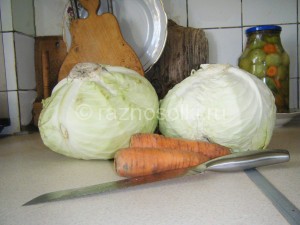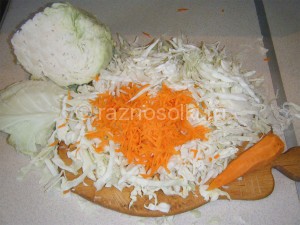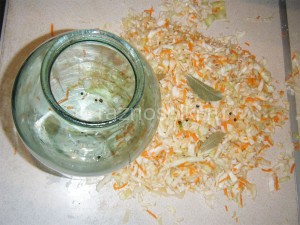How many kg of cabbage per 3 liter jar
Cabbage, whether fresh, pickled or canned, is the main component of many recipes for traditional dishes. a quick fix"in the diet of the autumn-winter table. We offer a simple recipe sauerkraut for the winter in jars, which will help out at any time. The method of preparing such a preparation is simple and does not require significant time or monetary investments.
The easiest way to serve sauerkraut is to add thinly sliced onions and season sunflower oil, it is better if it is unrefined, with the smell of seeds. As for the rest, it all depends on your imagination - green peas, fresh tomatoes, boiled potatoes, crispy pickles, apples, give an excellent taste combination with sauerkraut.
What is needed to make sauerkraut?
The set of products and available tools is elementary. Based on the volume of one 3-liter jar, you will need:
- fresh white cabbage;
- 1 large carrot;
- salt – 150 gr.;
- sugar – 100 gr.;
- large basin (plastic or enamel),
- sharp shredding knife,
- long wooden stick
- cutting board;
- three-liter jars.
How much cabbage is needed for canning? A large head of cabbage or several small ones – it doesn’t matter at all; their total mass should be at least 3.5-4 kg. Choose cabbage with dense and juicy leaves; they will give the juice required for preservation.
Do sauerkraut jars need to be sterilized? Yes, it is better to sterilize them by washing them thoroughly first.
How to easily prepare sauerkraut for the winter in 3-liter jars
- Chop the cabbage into strips 4-5 mm wide. If you cut it thinner, the cabbage will lose its crunch and become soft.
- Grate the carrots on a coarse grater.
- Place the vegetable mixture in a bowl, add salt and sugar. Then, with clean hands, mash the cabbage while mixing it with the salt. Don't overdo it; the goal in this process is to distribute the salt evenly.
- Place the cabbage in portions into a clean, dry jar, squeezing it thoroughly with your hand. Once the jar is filled, place it in a bowl and cover with a lid. Attention! The key word is to cover without closing, so that the juice can freely come out and flow down the jar. Wash it off daily. The jar should remain in this position at room temperature for at least 2-3 days, until all the excess liquid is released.
- 2-3 times a day, use a clean long wooden stick to pierce the cabbage to the very bottom of the jar. Taste the juice that comes out; its taste should be salty-sweet, with a pronounced salty edge. This means that you did everything right.
Is cabbage juice no longer coming out? This means the sauerkraut is ready. Close the 3-liter jars with a regular nylon lid and send them to a cool place. A cellar is perfect for this purpose. The prepared product will be stored for a very long time.
To prepare a 3-liter jar of sauerkraut, you need to spend 1 hour in the kitchen.
How to make sauerkraut
Hot sauerkraut
Products for a 3-liter jar
White cabbage - half a medium-sized head weighing 2 kilograms
Carrots - 2 medium sized pieces
Boiling water - 1.5 liters
Coarse rock salt - 2 tablespoons
Granulated sugar - 2 tablespoons
1. Wash and peel the carrots, cut using a special cutting board for vegetables. If it is not there, then cut it into large strips with a regular knife.
2. Peel the cabbage from coarse leaves and chop finely.
3. Mix cabbage and carrots in a deep bowl.
4. Place cabbage and carrots in a sterilized three-liter jar, compacting it thoroughly until the jar is completely filled.
4. Prepare the brine for the starter: put 1 tablespoon each of granulated sugar and rock salt into a measuring cup, pour boiling water over it.
5. Mix the brine and pour it over the cabbage in the jar so that it is completely hidden under the brine.
6. Place the jar of cabbage in a wide bowl or pan so that the cabbage juice does not overflow from the jar during fermentation.
7. Leave the cabbage for 2-3 days at room temperature, periodically (2-3 times a day) pressing the cabbage with a wooden stick (to reach the bottom of the jar), squeezing out the gas and removing the foam.
9. Cover the jar of sauerkraut with a lid and store it in the refrigerator.
Cold sauerkraut
Products for a 3-liter jar
White cabbage - 1 small head or half a large one, weighing about 2 kilograms
Carrots - 2-3 pieces weighing 300 grams
Rock salt - 40-50 grams to taste
How to cook sauerkraut
1. Remove the top green cabbage leaves.
2. Shred the cabbage using a board or a special cabbage grater.
3. Wash and peel the carrots, grate on a coarse grater.
4. Mix the cabbage and carrots thoroughly, adding the prepared salt.
5. When stirring, be sure to grind and crush the cabbage a little in a large container (you can take a basin) until the juice appears.
6. Place cabbage at the bottom of the jar, compacting it well.
7. After all the cabbage has been laid, cover it on top with cabbage leaves.
8. Place a plate or dish on top of the cooked cabbage, and put pressure on top (for example, a full kettle, jar or pan of water).
9. Leave the cabbage at room temperature for 3 days.
10. In order for gases to escape, you need to pierce the cabbage with a stick 3-4 times a day for all three days. You can determine that gases have escaped by the foam that forms during fermentation. As soon as the foam disappears completely (on the 2-3rd day), it means the cabbage is ready.
Fkusnofacts
Kitchen inventory for making sauerkraut: 3 liters glass jar, deep plate, cutting board and measuring cup. To cut cabbage and carrots, you need a cabbage grating board, and if you don’t have one, then an ordinary kitchen knife.
Before cutting cabbage, wash it and remove the top green leaves.
To make the cabbage softer in taste, you should add a little sugar to it (for our quantity - 2-4 tablespoons).
To make the cabbage crispy, you don’t need to knead it, it’s better to just mix it well. Be sure to use coarse salt for pickling. And if you want to diversify the taste, you can add lingonberries, cranberries or bell peppers to the cabbage.
Cabbage can be served simply as a side dish, or used as a side dish. In any case, it is recommended to chop the onions and add them to the cabbage. Then sprinkle a little granulated sugar to taste and vegetable oil. Leave to sit for a couple of hours. The longer it sits, the tastier it will be. Only coarse rock salt is used for cabbage. And in order for it to be crispy, after the gases have escaped, it is recommended to put the cabbage in the cold.
Cabbage is selected for pickling late varieties so that the sauerkraut is crispy. Usually this is mid-autumn. You need to select cabbage with green leaves for fermentation, even though you will remove them later. They choose it this way because without green leaves it may end up frozen, and this one is no longer suitable for pickling.
You can also diversify the taste of cabbage; to do this, during the cooking process, before you put it in, add cranberries or lingonberries, fruits or mushrooms. Can be seasoned with spices.
Sauerkraut is stored all winter until spring in the refrigerator or on an open balcony.
Cabbage stalks are not used for pickling.
Classic proportions for pickling cabbage: for 1 kilogram of cabbage, 100 grams of carrots and 10 grams of salt.
The optimal temperature for fermenting cabbage is +2 - +15 degrees.
If mold has formed while the cabbage is steeping, it must be removed, and the cabbage and plate must be thoroughly washed under cold water.
When fermenting cabbage, the foam must be removed, and the cabbage must also be pierced. Otherwise, the cabbage will turn out bitter.
For example, a cobblestone or a 2-liter bottle of water is suitable as oppression. The oppression must be thoroughly washed, because with a cold storage method, juice is released - if it comes into contact with a non-sterile pressure, it is likely that the sauerkraut will spoil.
Sauerkraut can be stored for 3-4 months. The open jar is consumed within 2 weeks, otherwise it will become bitter (then the cabbage is put into How to cook sauerkraut "0.0 / 5 Total votes: 1
Sauerkraut can be prepared and eaten in any season, but it so happens that the main period of consumption of this dish is autumn and winter. A traditional dish of many peoples is not only easy to prepare and carries a vitamin “load”, so necessary in the absence of sufficient fruit and vegetable nutrition in the winter, but is also an ideal addition to many dishes - potatoes (cooked in any way), to porridges , as an independent salad dish, in vinaigrette.
In addition, sauerkraut can be used as a filling for pies, pies and in first and second courses.
When fermenting cabbage, additional ingredients can be used (cranberries, apples, carrots, sweet pepper, raisins), to give the dish different shades of taste.
I kept in mind the recipe for 10 kg. 200 grams of cabbage were added. salt, but since I was preparing 1-2 three-liter jars at a time, I had to constantly calculate the proportion of salt.
A couple of years ago, everything became simpler - I just started mashing cabbage with salt, making it taste like a “very salty salad.”
So, for one 3-liter jar we need:

Cabbage - 2 medium heads;
Carrots – 2 pcs. (one piece per head);
Bay leaf – 3-5 pcs.;
Black peppercorns – 10-12;
Salt (not iodized).
Cooking process
1. Cabbage is cut according to your preference, some like it thinly, small, and some like it larger. Carrots are grated. 
2. The entire volume is mixed and kneaded with salt (for convenience, this can be done in two batches).
3. Then put a bay leaf and peppercorns (not all) into the jar and fill the container with tightly “trodden down” cabbage. During the process, the remaining bay leaf and pepper are added. If desired, you can add allspice and cloves. This time I prepared, let’s say, a “classic” with a minimum amount of ingredients.

4. The filled bottle is placed in a plate or bowl so that the juice flows into this container. A couple of times a day it is necessary to pierce the cabbage, releasing the gas that is formed during souring.
It is very convenient to use wooden sticks designed for Japanese cuisine. I also have three rules that I adhere to when preparing sauerkraut - I don’t make cabbage during the full moon and on “ women's days", and choose cabbage with white, dense leaves (which I would not use in a fresh salad because of its toughness).
5. When the cabbage stops releasing juice, after 2-4 days (depending on the room temperature), it should be lowered into the basement or hidden in the refrigerator.
Now you can replenish your vitamin supply and eat simply by adding onions, herbs and fragrant vegetable oil to the cabbage.
Bon appetit!
Popular
- Kiss tattoo for men. Kiss tattoo. The meaning of tattoos for men
- The safety of plastic toys
- Winter safety shoes: men's and women's, insulated
- Increased protein in urine: possible causes and treatment Quantitative methods of assessment
- We knit booties with knitting needles: elegant and casual patterns, patterns with descriptions and recommendations
- How is World Heart Day celebrated?
- Knitted children's pullover with cat applique
- You need to know this: how to get a ticket to kindergarten - step-by-step instructions for parents
- Birthday card for grandma from her grandson or granddaughter
- Making three-dimensional numbers and letters with your own hands Make the number 7 from a diaper




